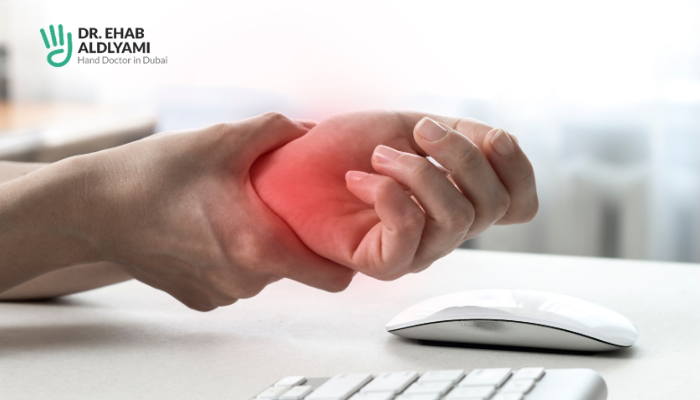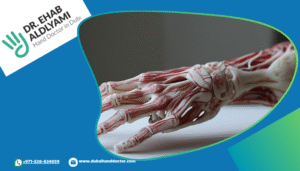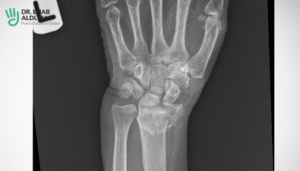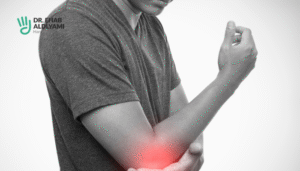The hidden danger to the hand from phone and computer

The ease of modern technology has a downside. Using smartphones and computers can stress our hands and wrists’ delicate tendons and nerves.
This persistent strain can cause various issues, from a simple ache to more serious chronic conditions.
This article will explain what to look out for and how to prevent hidden hand pain from gadgets so you can continue to use your devices without pain.
Understanding "Digital Discomfort"
The term “digital discomfort” refers to a range of symptoms and conditions that arise from the overuse of digital gadgets. It’s a modern phenomenon that highlights the strain our hands and wrists endure.
The frequent, repetitive motions of typing, swiping, and gaming are unnatural for our hands, and they were designed for different tasks.
Continuous stress on your tendons, nerves, and joints can result in long-term inflammation and injury.
This isn’t just a simple ache; it’s a form of repetitive strain injury (RSI). One of the most common issues is hand pain from phone use, often manifesting as pain in the thumb, wrist, and forearm.
This is a direct result of the “claw grip” we often use to hold our phones and the repetitive tapping or swiping with our thumbs. Similarly, long hours spent at a desk can lead to computer-related hand injuries.
Carpal tunnel syndrome can develop when awkward wrist positions, often from using a keyboard and mouse, put pressure on the median nerve in the wrist.
In other cases, the repetitive clicking of a mouse can cause inflammation in the tendons, leading to conditions like De Quervain’s tenosynovitis, also known as “gamer’s thumb.”
The alarming symptoms of hand injury
Recognizing the early symptoms of hand injury is key to preventing minor discomfort from becoming a chronic problem. You should pay close attention to the following signs:
Pain and aches: Persistent pain in your hand, wrist, or forearm that doesn’t go away after a few hours of rest. This is often the first and most obvious sign.
Numbness or tingling: A tingling or “pins and needles” sensation in your fingers, particularly the thumb, index, middle, and ring fingers. This is a classic symptom of nerve compression, such as carpal tunnel syndrome.
Stiffness: You may experience stiffness in your fingers or wrist, which can limit your range of motion, especially when you wake up.
Weakness: Difficulty gripping objects, opening jars, or performing other tasks that require hand strength. You may drop things more frequently.
Swelling: Noticeable swelling in your hands or wrists, which indicates inflammation.
Clicking or catching: A snapping or clicking sound or sensation when you move your thumb or fingers, which can be a sign of inflamed tendons.
If you experience any of these symptoms, it’s a warning sign that your current tech habits are taking a toll on your hands. If you ignore these signs, you could face more severe and long-lasting problems.
The constant pressure and repetitive motions on our hands can result in significant pain and discomfort, and potentially lead to chronic conditions if not addressed.
Preventing hand strain from phone and computer
The good news is that much of this hand injury is preventable. You can significantly reduce the risk of developing these painful conditions by making small, mindful changes to your daily habits.
Change your grip: Instead of “clawing” your phone, hold it with a looser grip and use your index finger to scroll or tap. This simple change reduces the strain on your thumb and the surrounding tendons.
Take breaks: For every 20 minutes you spend on a screen, give your eyes a break by looking at something 20 feet away for 20 seconds. Extend this to your hands by taking a break from typing or swiping every 20 minutes to stretch and relax your hands and wrists.
Use ergonomic tools: If you spend much time on a computer, invest in an ergonomic keyboard and mouse. These tools are designed to neutralize your wrists, reducing pressure on your nerves and tendons.
Stretch regularly: Perform simple hand and wrist stretches throughout the day. Gentle exercises like wrist extensions, flexions, and finger stretches can improve flexibility and blood flow, preventing stiffness and pain.
Adjust your setup: To ensure proper posture at your computer, position your keyboard and mouse to keep your wrists straight. Your elbows should be bent at a 90-degree angle and your feet flat on the floor.
Use voice-to-text: Take advantage of voice-to-text features on your phone and computer. This is a great way to reduce your typing and give your hands a much-needed break.
The link between smartphone use and hand pain is undeniable. The key is to be proactive and not wait for the pain to become unbearable. These preventive measures will allow you to continue using technology while keeping your hands healthy.
Understand available treatment options
If you’re experiencing mild hand pain, the first step is to reduce your phone and computer use. If the pain is more severe or persistent, it’s time to seek professional medical care.
Hand therapy: Hand therapy is a great way to address muscular weakness, which can cause overuse issues. By providing targeted stretches and exercises, a hand therapist can help relieve pain, improve function, and strengthen the muscles in your fingers, wrists, and forearms.
Medical interventions: A doctor may recommend other treatments depending on the specific condition. For certain types of tendonitis or persistent trigger thumb, a steroid injection may be a practical solution. A minor surgical procedure might be necessary for issues that do not improve with other treatments.
When to seek professional help?
While lifestyle changes are crucial for prevention, there are times when professional help is necessary. If your hand pain is persistent, severe, or accompanied by numbness and weakness, it’s time to consult with a specialist. A hand and wrist expert can accurately diagnose and recommend a personalized treatment plan.
As a leading orthopedic hand specialist in Dubai, Dr. Ehab Aldlyami is highly experienced in treating hand injuries and pain conditions. Depending on the diagnosis, treatment options can range from physical therapy and steroid injections to minimally invasive surgical procedures.
Dr. Ehab Aldlyami’s goal is to provide a path to effective recovery tailored to your needs, helping you return to a life free from pain and discomfort.
Don’t let technology’s convenience become a source of chronic pain.By being aware of the risks and taking proactive steps, you can protect your hands from the hidden hand injury of the digital age.
Don’t hesitate to schedule a consultation today if you’re experiencing any of these symptoms or have concerns about your hand health. Your hand health is an investment in your long-term well-being.

Related Post

مدة علاج العظم الزورقي: كل ما تحتاج معرفته عن علاج كسر العظم الزورقي
العظم الزورقي هو أحد العظام الصغيرة الموجودة في اليد التي تقع في المعصم. بالرغم من

اعراض وعلاج تمزق اربطة اليد
تمثل اليد أحد أكثر أجزاء الجسم استخدامًا في الحياة اليومية، مما يجعلها عرضة للإصابات

Scaphoid fracture: Causes, symptoms & treatment options
In the world of hand and wrist injuries, few conditions are as deceptively subtle yet

What to Know About a Distal Radius Fracture: Causes, Symptoms & Treatment
The distal radius fracture is the most common broken wrist. It can follow a simple

5 Common Hand Disorders & Their Treatments
Our hands play an essential role in nearly every task we do, from simple daily

Hand Pain Isn’t Always What It Seems: Insight from a Doctor
We use our hands for nearly everything — from sending texts to cooking dinner or




